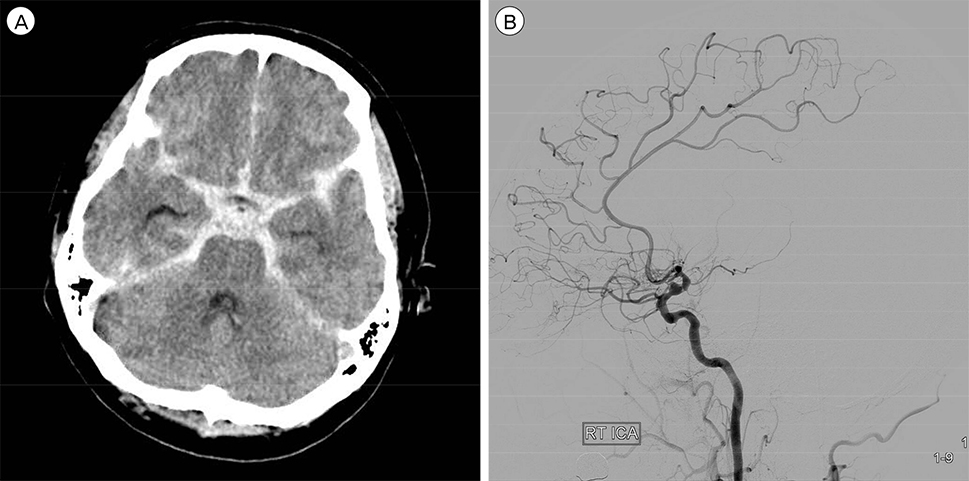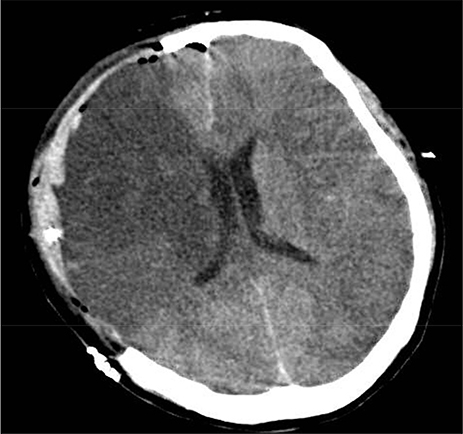J Cerebrovasc Endovasc Neurosurg.
2017 Jun;19(2):125-128. 10.7461/jcen.2017.19.2.125.
Simultaneous Onset of Ischemic and Hemorrhagic Stroke Due To Intracranial Artery Dissection
- Affiliations
-
- 1Department of Neurosurgery, College of Medicine, Yeungnam University, Daegu, Korea. cch0102@ynu.ac.kr
- KMID: 2393392
- DOI: http://doi.org/10.7461/jcen.2017.19.2.125
Abstract
- Intracranial dissections commonly present as ischemic stroke and as hemorrhagic stroke. In general, while either ischemic stroke or hemorrhagic stroke may develop, the simultaneous onset of both may also occasionally occur. In this report, we present a case of simultaneous development of ischemic stroke and hemorrhagic stroke due to an intracranial artery dissection.
Keyword
Figure
Reference
-
1. Alotaibi NM, Fugate JE, Kaufmann TJ, Rabinstein AA, Wijdicks EF, Lanzino G. Intracranial supraclinoid ICA dissection causing cerebral infarction and subsequent subarachnoid hemorrhage. Neurocritical Care. 2013; 04. 18(2):252–256.
Article2. Friedman AH, Drake CG. Subarachnoid hemorrhage from intracranial dissecting aneurysm. J Neurosurg. 1984; 02. 60(2):325–334.
Article3. Kato Y, Hayashi T, Uchino A, Kakehi Y, Yamane F, Ishihara S, et al. Fusiform dilatation of the outer contour of a dissected anterior cerebral artery revealed by magnetic resonance cisternography in a patient with simultaneous cerebral infarction and subarachnoid hemorrhage. J Stroke Cerebrovasc Dis. 2014; 07. 23(6):1717–1720.
Article4. Krishnakumar K, Menon G, Kesavadas C, Nair S, Rao BR, Easwer HV. Dissecting intracranial aneurysms presenting as subarachnoid haemorrhage: report of two cases and review of literature. Br J Neurosurg. 2008; 12. 22(6):801–804.
Article5. Metso TM, Metso AJ, Helenius J, Haapaniemi E, Salonen O, Porras M, et al. Prognosis and safety of anticoagulation in intracranial artery dissections in adults. Stroke. 2007; 06. 38(6):1837–1842.
Article6. Nakiri GS, Al-Khawaldeh M, Parente B, Kessler I, Gory B, Riva R, et al. Treatment of ruptured intra-cranial internal carotid artery dissection using a flow-diverter stent. J Neuroradiol. 2012; 10. 39(4):271–275.
Article7. Ota N, Tanikawa R, Kamiyama H, Miyazaki T, Noda K, Katsuno M, et al. Discrepancy between preoperative imaging and postoperative pathological finding of ruptured intracranial dissecting aneurysm, and its surgical treatment: case report. Neurol Med Chir (Tokyo). 2014; 54(3):219–226.
Article
- Full Text Links
- Actions
-
Cited
- CITED
-
- Close
- Share
- Similar articles
-
- Subsequent Subarachnoid Hemorrhage from Clinically Unrelated Vertebral Artery Dissection after Thrombolytic Therapy
- Surgical Treatment of Cerebral Ischemia
- Percutaneous Transluminal Angioplasty of Intracranial Artery for the Treatment of Acute Ischemic Stroke
- Two Cases of Subarachnoid Hemorrhage from Spontaneous Anterior Cerebral Artery Dissection : A Case of Simultaneous Hemorrhage and Ischemia Without Aneurysmal Formation and Another Case of Hemorrhage with Aneurysmal Formation
- Cerebrovascular Disease : Overview and Classification




